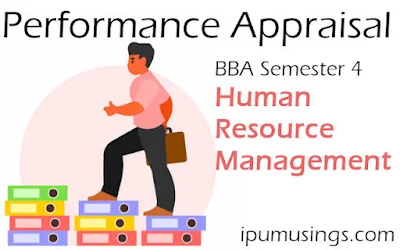BBA Semester 4 - Performance Appraisal - Human Resource Management #bba #ggsipu #hrm #ipumusings #MBA
BBA Semester 4 - Performance Appraisal - Human Resource Management
Q1: What is performance appraisal?
Answer: It is the process of formally evaluating performance and feedback to an employee. Performance appraisal is the process of assessing quantitative and qualitative aspects of an employee's job performance.
Performance appraisal is one of the most important human resource management practices.
Q2: What is the purpose of performance appraisal?
Answer:
1. Evaluation — document and let people know how well they are doing; judgmental role.
2. Development — identify how training and support can improve performance; counselling role.
Q3: What are the benefits of performance appraisal?
Answer:
⊛ Suitable Placements
⊛ Assistance in self-improvement
⊛ Incentives to grow and develop
⊛ Effective Training Programme
⊛ Introduction of sound Personnel Policies
⊛ Cordial Employers- Employees Relations
⊛ HRP &HRD
⊛ Employee Communication
⊛ High Employee Morale
Q4: What are the limitations of performance appraisal?
Answer:
⊛ Time-consuming and huge paperwork involved
⊛ Limited Stress on self-improvements
⊛ Ineffective communication
⊛ Absence of Uniform Standards
⊛ Absence of effective participation of employees
⊛ Resistance of employee to appraisal
⊛ Halo effect
⊛ Horn effort
⊛ Personal bias
⊛ Defective appraisal by superiors
Q5: What are the two main techniques of performance appraisals?
Answer: Two methods are:
- Trait Approach
- Modern Approach
Trait Approach includes:
⊛ Ranking Method
⊛ Paired Comparison
⊛ Grading Method
⊛ Forced Rating Method
⊛ Checklist method
⊛ Graphic Rating Scales
⊛ Critical Incident Method
⊛ Essay Method
⊛ Field review Method
The modern approach includes:
⊛ Human Resources Accounting method
⊛ MBO (Management By Objectives)
⊛ Assessment Centers
⊛ BARS (Behaviourly Anchored Rate Scale)
⊛ 360 Degree Appraisal
Q6: Define in one line the following:
(a) Critical Incident Technique
(b) 360 Degree feedback
(c) Multi-person Comparison
(d) Graphic Rating Scale
Answer:
(a) Critical Incident Technique: Keeps a log of a person’s affective and ineffective job behaviour
(b) 360 Degree feedback: Includes superiors, subordinates, peers and even customers in the appraisal process
(c) Multi-person Comparison: Rates employees against each other
(d) Graphic Rating Scale: Uses a checklist of characteristics or traits to evaluate performance.
Q7: Explain the behavioural Anchored rating scale.
Answer: BARS uses specific descriptions of actual behaviours to rate various levels of actual performance. It is used in various domains like customer feedback, employee appraisal.
It uses a scale from 1 to 5 (5: Outstanding performance, 1: Unsatisfactory performance).
Scale 5: The employee cheerfully works with the customer until they find exactly what they need.
Scale 4: The employee asks what the customer is looking for and checks in once to see how they are doing.
Scale 3: The employee asks what the customer is looking for but doesn't offer much assistance.
Scale 2: The employee says hello when customers enter the store but do not ask what they are looking for.
Scale 1: The employee does not talk to or make eye contact with customers when they enter the store.
Q8: Define the responsibilities of the following in a performance appraisal system?
(a) the company
(b) the manager
(c) the employee
Answer:
(a) The company
- creates the strategic plan
- Provides support and resources
(b) The manager
- identifies job requirements and job goals
- observes and documents employee performance
- help employees in creating their action plans
- Provides ongoing feedback to the employee
- Provides support and resources
(c) The employee
- listens to and acts on feedback from the manager
- Meets requirements and goals in order to succeed.
- Provides feedback to the manager about the work environment
👉See Also:




